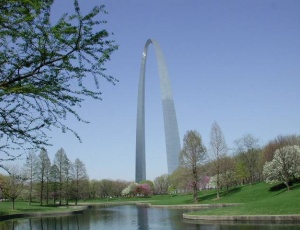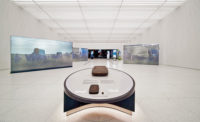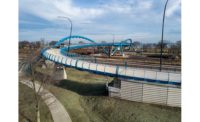In 1947, a visionary named Eero Saarinen won an architectural competition to design what would become his best-known structure, the Gateway Arch in St. Louis.

In September, the winner of a similar competition will be revealed. This time, the landmark project will breathe new life into the riverfront park 630 ft below the top of Saarinen�s famous stainless steel, inverted catenary arch.
Five international teams have made it to the finals of the juried design competition, chosen from a pool of more than 110 portfolios, says Tom Bradley, superintendent of the Jefferson National Expansion Memorial, the National Park Service property in St. Louis that includes the Arch.
The schedule calls for the five teams to make formal presentations to the eight-member jury Aug. 26, with the selection announcement scheduled for Sept. 24.
�There�s been a growing concern over the last few years that the park, while still pulling in a lot of visitors, could be a lot more and a lot better,� Bradley says. The Arch was topped off in 1965 and the landscaping of the grounds took shape in the 1970s, but �not much has happened since then,� he says.
Among the complaints cited most often is the perception that the Arch grounds are cut off from the rest of downtown St. Louis by Memorial Drive and the below-grade lanes of Interstate 70. Bradley says all five finalists have devised some way to improve accessibility.
�They all have a variation of a lid or deck over the interstate.�
Another common theme among the finalist proposals: making the underground museum at the base of the Arch more inviting, perhaps with massive skylights. All of the plans include significant landscaping changes and varying levels of structural development throughout the Arch grounds.
Designers were also charged with joining both sides of the Mississippi River by finding a way to link the 91-acre park on the west side with new developments on the primarily industrial east bank.
The Behnisch Architekten team of Stuttgart, Germany, proposes a floating stage on the east side of the river, in front of permanent theater seating, accessible from the Arch grounds by a gondola ride spanning the massive river.
The Weiss/Manfredi group of New York foresees parkland on the east side and a new stage on the west.
The MVVA team of Cambridge, Mass., and Brooklyn, N.Y., takes an ecological approach that includes a wetland reserve.
The team of PWP Landscape Architecture, Foster + Partners and Civitas of Denver, London and Berkeley, Calif., includes an earthen mound and greenhouses across the river plus additional work west of the Arch grounds to better incorporate Luther Ely Smith Square and Kiener Plaza downtown.
And the SOM Hargreaves BIG team of Chicago, San Francisco and Copenhagen includes a performance space on the east side of the river and pedestrian connections across the Mississippi.
Once the winning design team is chosen, project leaders will seek private donations to fund the design and get the ball rolling quickly, with a goal of wrapping it up by the 50th anniversary of the Arch�s topping out, which would be fall 2015.
Bradley says, �We don�t want to have a long period of time when nothing happens,� a contrast to the original Arch development when two decades passed between the choice of designer and the grand opening.
No price tag has been set, but the project has earned the attention of federal government higher-ups, who have promised to make funding a priority.
Interior Secretary Ken Salazar visited St. Louis Aug. 20 to view the plans and was accompanied by U.S. Sen. Claire McCaskill of Missouri, who promised that she would push for federal funds supported by local efforts.



Post a comment to this article
Report Abusive Comment